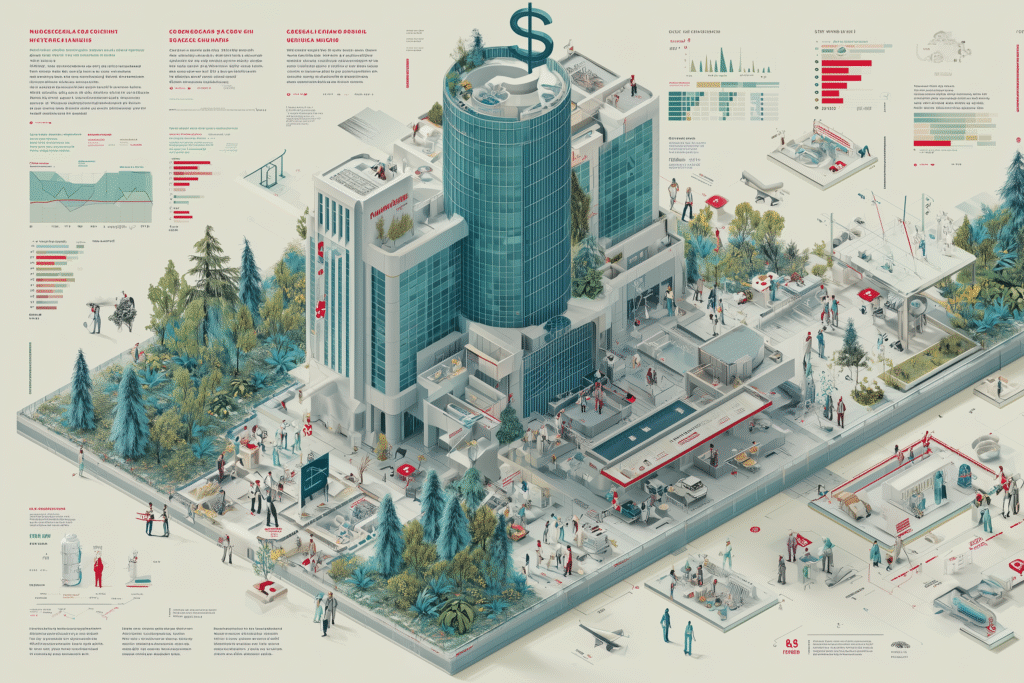We’re living in the age of medical miracles—precision diagnostics, billion-dollar treatments, and global health campaigns.
And yet, we’ve never been sicker.
Note: This article is for educational and informational purposes only. See full disclaimer at the end.
This isn’t opinion—it’s mathematical fact backed by decades of data. And it reveals the most confounding paradox of our time: the more sophisticated our healthcare becomes, the worse our health gets.
Today, we begin a journey into understanding why this is happening and, more importantly, how consciousness, AI, and holistic health integration can finally break this devastating cycle.
The Numbers Don't Lie
Let’s start with the raw data that shows just how deep this paradox runs.
Healthcare Spending: More Money, Worse Outcomes
The United States spends nearly 18% of its GDP on healthcare—more than any other country in history—yet Americans die younger and are less healthy than residents of other high-income nations². By 2033, spending is projected to exceed 20% of GDP, totaling over $4 trillion annually¹.
In 2021 alone, global spending on health reached a staggering $9.8 trillion, accounting for 10.3% of global GDP³.
Yet despite this unprecedented investment, over the last decade, life expectancy has stagnated in many countries, including the United States, which dedicates more resources to healthcare than any nation in history³.
The comparison with other developed nations is stark: Germany spends less on health care per capita than the U.S., yet life expectancy at birth is nearly four years higher².

Chronic Disease: The Growing Epidemic
129 million Americans—nearly 40% of the population—have at least one major chronic disease such as heart disease, cancer, diabetes, obesity, or hypertension⁴. Even more concerning: 42% have two or more, and 12% live with five or more simultaneously⁴.
The financial burden is staggering: About 90% of the annual $4.1 trillion health care expenditure is attributed to managing and treating chronic diseases and mental health conditions⁴.
Breaking down the specific conditions:
Obesity: The prevalence of obesity among U.S. adults 20 and over was 41.9% during 2017–March 2020⁵. This represents more than 100 million adults, with annual medical costs for adults with obesity averaging $1,861 more per person than adults with healthy weight⁵.
Heart Disease: Despite being preventable in most cases, heart disease remains the leading cause of death in the U.S., according to a new report from the American Heart Association; yet fewer than half of survey respondents knew that⁶. Heart disease has now been the leading cause of death in this country for 100 years straight, since 1921⁶.
Diabetes and Prediabetes: Combined, these conditions affect around 42% of the U.S. population in 2022—with diabetes alone affecting approximately 11% and prediabetes affecting another 31%—nearly twice the rate seen in comparable nations⁷.
Mental Health: The Hidden Crisis
The mental health statistics are equally alarming:
Depression and Anxiety: In the first year of the COVID-19 pandemic, global prevalence of anxiety and depression increased by a massive 25%⁸. Depression and anxiety are estimated to cause a global loss of 1 trillion USD in productivity each year⁹.
In the U.S., 43% of adults say they feel more anxious than they did the previous year, up from 37% in 2023 and 32% in 2022. Meanwhile, 57.8 million adults (19% of the country) had a mental illness, but only 43% received any kind of mental health care¹⁰ ¹¹.

Economic Impact: Depression and anxiety disorders cost the global economy $1 trillion in lost productivity each year, while mental health conditions could cost the economy as much as $16 trillion between 2011 and 2030⁹ ¹².
But the crisis extends beyond mental health to our most fundamental biological input: food itself. The foundation of biological intelligence has been systematically compromised.
Nutrition: The Foundation Crumbling
Perhaps most shocking is what’s happened to our food supply.
Nutrient Decline: In the last sixty years, there has been an alarming decline in food quality and a decrease in a wide variety of nutritionally essential minerals and nutraceutical compounds in essential fruits, vegetables, and food crops¹³.
The average vegetable found in today’s supermarkets are 5%-40% lower in mineral content than those from over 50 years ago¹⁴. Additionally, of the 13 most important nutrients in your fruits and vegetables, 6 of their levels have declined substantially¹⁵.
Ultra-Processed Food Dominance: Ultra-processed food consumption grew from 53.5 percent of calories in the beginning of the period studied (2001-2002) to 57 percent at the end (2017-2018)¹⁶. The U.S. leads the world, with 60% of caloric intake from ultra-processed foods, compared to 14-44% in Europe¹⁷.

The Paradox Crystallized
Here’s the paradox in its starkest terms:
- More medical technology → Higher disease rates
- More healthcare spending → Shorter lifespans
- More food production → Less nutritious food
- More mental health awareness → More mental health crises
- More fitness tracking → More sedentary lifestyles
- More health information → More confused consumers
We’re experiencing what can only be called an inverse relationship between healthcare advancement and human health.
While this analysis focuses primarily on U.S. data—where the paradox is most pronounced—similar patterns emerge across developed nations worldwide, suggesting this isn’t merely an American problem but a fundamental flaw in our approach to health itself.
So how did we get here? Why does advancing technology correlate with declining health?
Why This Is Happening
The root of this paradox lies in a fundamental misunderstanding of what health actually is.
The System vs. Symptoms Approach
Our current healthcare system operates on what I call the Symptom Management Paradigm:
- Wait for disease to appear
- Diagnose the condition
- Prescribe treatment for symptoms
- Manage the condition indefinitely
- Add more treatments as new symptoms emerge
This approach treats the human body like a car in a repair shop—fix what’s broken, patch what’s failing, replace what’s worn out. But human biology doesn’t work like mechanical systems.

The Consciousness-Health Disconnect
What we’ve lost is the understanding that health is fundamentally a state of consciousness.
Every cell in your body is constantly receiving, processing, and responding to information. Your immune system makes millions of decisions every second. Your nervous system coordinates incomprehensible complexity. Your endocrine system balances dozens of hormones in real-time.
This isn’t mechanical—it’s conscious biological intelligence.
Every cell operates as part of an integrated quantum system—a concept we explored deeply in The Quantum Body.
But our healthcare system treats this intelligence as if it doesn’t exist. We’ve reduced living systems to chemical reactions and physical structures, ignoring the consciousness that coordinates it all.
The AI Mirror
In a twist of poetic irony, artificial intelligence is showing us what we’ve forgotten: that biological intelligence was always advanced, adaptive, and awe-inspiring.
We’re trying to mimic in machines what we’ve neglected in ourselves.
As we develop AI systems that can process vast amounts of information, recognize patterns, and make complex decisions, we’re rediscovering that these are exactly the capabilities that healthy human biology demonstrates every moment.
The difference? Human biological intelligence is conscious. It can learn, adapt, heal, and optimize in ways that our current AI systems cannot.
The paradox exists because we’re trying to replace conscious biological intelligence with mechanical medical management—and it’s not working.

The Path Forward
The solution isn’t to abandon modern medicine or return to pre-technological healthcare. The solution is to integrate consciousness into our approach to health.
This means:
Personal Level: Understanding that you are not a passive recipient of healthcare but an active participant in conscious biological optimization. This builds directly on our previous exploration of Signal Detection and Quantum Wisdom Translation.
Technological Level: Using AI to augment rather than replace human biological intelligence—an approach rooted in our earlier exploration of conscious AI partnership.
Systemic Level: Shifting from symptom management to consciousness support and optimization.
Over the course of this upcoming journey, we’ll explore exactly how to make this integration practical, sustainable, and transformative.
What's Coming
To solve a systemic crisis, we need a system-level solution—one rooted not in control, but in coherence.
I am going to share with you something which I have built that I call the Conscious Health System—by applying the Reality Architecture principles, we’ll explore a comprehensive approach that integrates:
- Signal detection and translation (applying our quantum biology frameworks to health optimization)
- AI-augmented wellness architecture (technology that supports rather than replaces biological intelligence)
- Nutritional consciousness (food as information rather than just fuel)
- Movement as coherence training (building on our earlier work on movement and flow)
- Environmental design for health (spaces that support biological optimization)
- Mental and spiritual health integration (meditation, prayer, and consciousness practices)
Each component will build on the frameworks we’ve already developed while creating new tools specifically for health transformation.

The Promise
Here’s what becomes possible when we resolve this paradox:
Instead of managing disease, we optimize consciousness. Instead of treating symptoms, we enhance biological intelligence. Instead of fighting against our bodies, we work with our natural healing capabilities. Instead of expensive, reactive healthcare, we invest in sustainable, proactive health creation.
The health paradox isn’t just a statistical anomaly. It’s a wake-up call—an invitation to evolve how we define, support, and create health from the inside out.
Tomorrow, we dive deeper into why our current systems keep us sick and what a truly proactive approach looks like.
The most powerful technology we’ve overlooked isn’t in a laboratory or a hospital.
It’s the conscious biological intelligence you already possess.
See you in the next insight.
Comprehensive Medical Disclaimer: The insights, frameworks, and recommendations shared in this article are for educational and informational purposes only. They represent a synthesis of research, technology applications, and personal optimization strategies, not medical advice. Individual health needs vary significantly, and what works for one person may not be appropriate for another. Always consult with qualified healthcare professionals before making any significant changes to your lifestyle, nutrition, exercise routine, supplement regimen, or medical treatments. This content does not replace professional medical diagnosis, treatment, or care. If you have specific health concerns or conditions, seek guidance from licensed healthcare practitioners familiar with your individual circumstances.
References
- National Health Expenditure Projections, 2023–32: Health Affairs Journal. “National Health Expenditure Projections, 2023–32: Payer Trends Diverge As Pandemic-Related Policies Fade.” June 12, 2024. https://www.healthaffairs.org/doi/10.1377/hlthaff.2024.00469
- U.S. Health Care from a Global Perspective, 2022: Commonwealth Fund. “U.S. Health Care from a Global Perspective, 2022: Accelerating Spending, Worsening Outcomes.” January 2023. https://www.commonwealthfund.org/publications/issue-briefs/2023/jan/us-health-care-global-perspective-2022
- Global Healthcare Spending Analysis: World Economic Forum. “Health spending takes up 10% of global GDP. Can tech reduce those costs – and improve lives?” August 2024. https://www.weforum.org/stories/2024/08/healthcare-costs-digital-tech/
- Chronic Disease Prevalence in the US: Centers for Disease Control and Prevention. “Chronic Disease Prevalence in the US: Sociodemographic and Geographic Variations by Zip Code Tabulation Area.” 2024. https://www.cdc.gov/pcd/issues/2024/23_0267.htm
- Adult Obesity Facts: Centers for Disease Control and Prevention. “Adult Obesity Facts | Obesity | CDC.” March 25, 2025. https://www.cdc.gov/obesity/adult-obesity-facts/index.html
- Heart Disease Statistics: American Heart Association. “More than half of U.S. adults don’t know heart disease is leading cause of death, despite 100-year reign.” 2024. https://newsroom.heart.org/news/more-than-half-of-u-s-adults-dont-know-heart-disease-is-leading-cause-of-death-despite-100-year-reign
- Chronic Disease Burden Comparison: Peterson-KFF Health System Tracker. “How has the burden of chronic diseases in the U.S. and peer nations changed over time?” April 16, 2025. https://www.healthsystemtracker.org/chart-collection/how-has-the-burden-of-chronic-diseases-in-the-u-s-and-peer-nations-changed-over-time/
- COVID-19 Mental Health Impact: World Health Organization. “COVID-19 pandemic triggers 25% increase in prevalence of anxiety and depression worldwide.” March 2, 2022. https://www.who.int/news/item/02-03-2022-covid-19-pandemic-triggers-25-increase-in-prevalence-of-anxiety-and-depression-worldwide
- Mental Health Economic Impact: Huntington Psychological Services. “The Latest Mental Health Statistics: What the Numbers Say About the State of Our Minds in 2024.” August 14, 2024. https://huntingtonpsych.com/the-latest-mental-health-statistics-what-the-numbers-say-about-the-state-of-our-minds-in-2024
- American Psychiatric Association Poll: Psychiatry.org. “American Adults Express Increasing Anxiousness in Annual Poll; Stress and Sleep are Key Factors.” 2024. https://www.psychiatry.org/news-room/news-releases/annual-poll-adults-express-increasing-anxiousness
- Mental Health Treatment Statistics: The Zebra. “Mental Health Statistics in 2025.” July 26, 2024. https://www.thezebra.com/resources/research/mental-health-statistics/
- Global Mental Health Crisis: Project HOPE. “The Global Mental Health Crisis: 10 Numbers to Note.” May 20, 2024. https://www.projecthope.org/news-stories/story/the-global-mental-health-crisis-10-numbers-to-note/
- Nutritional Quality Decline: MDPI Foods Journal. “An Alarming Decline in the Nutritional Quality of Foods: The Biggest Challenge for Future Generations’ Health.” March 14, 2024. https://www.mdpi.com/2304-8158/13/6/877
- Nutrient Density Decline: New Chapter. “How Nutrient Density in Produce has Declined Over Time.” May 1, 2024. https://www.newchapter.com/wellness-blog/how-nutrient-density-in-produce-has-declined-over-time/
- USDA Nutrient Content Changes: PubMed. “Changes in USDA food composition data for 43 garden crops, 1950 to 1999.” December 2004. https://pubmed.ncbi.nlm.nih.gov/15637215/
- Ultra-Processed Food Consumption: NYU News. “Americans Are Eating More Ultra-Processed Foods.” October 2021. https://www.nyu.edu/about/news-publications/news/2021/october/ultra-processed-foods.html
- Ultra-Processed Food Comparison Study: medRxiv. “Ultra-processed food staples dominate mainstream U.S. supermarkets. Americans more than Europeans forced to choose between health and cost.” February 17, 2024. https://www.medrxiv.org/content/10.1101/2024.02.16.24302894v1.full


